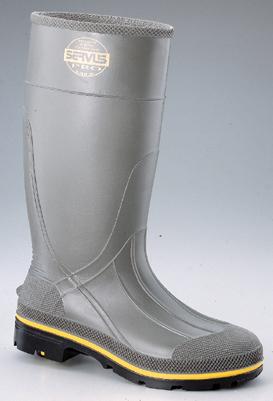Industrial Footwear, Boots, Toe Guards, Insoles
For industrial safety footwear, protection is still a priority, but comfort and style are essential features to have, not just options anymore for safety footwear.
Norcross has a pretty snazzy looking rubber, steel toed boot called "Super Boot," with safety-yellow coloring that seems to be a hit. Norcross designed the Super Boot for heavy-duty industrial applications, even though they weren’t trying for protection, they actually reached a new level in steel toed rubber boots style.
Consumer interest in safety shoes, steel toe rubber boots and overshoes now drives a new market that removes a noticeable gap between safety and casual footwear. The newer trend of safety footwear looking and wearing like comfortable athletic shoes and casual dress shoes and boots is also continuing at an accelerated pace. Manufacturers are taking note of this new trend and are developing more comfortable safety footwear, rubber boots and safety shoes.
Some might think adequate foot protection is routine, but consider some of these statistics: * More than 8.7 million workers are exposed to foot hazards, according to OSHA's Office of Regulatory Analysis. * Workers suffered 160,000 foot and toe injuries in 1993, according to the National Safety Council. * In 1979, the Bureau of Labor Statistics reported, three out of four people who suffered foot injuries were not wearing appropriate foot protection. Due to advances in protective technology, the percentage is probably higher today.
Even though Norcross named their boot “Super Boot” there are no "super" safety footwear that can protect against all potential foot hazards. In its 1994 update of personal protective equipment (PPE) standards, OSHA recognized as much when it required employers to conduct "hazard assessments" to determine what hazards are present and what PPE provides adequate protection in a safety area such as safety footwear.
Safety footwear usually is listed or has combined features in the following major categories: * Steel toed boots, which combines a traditional work boots or safety shoes with a steel toe to protect against falling objects. There are some separate accessories such as shin guards, instep guards, metatarsal guards, that provide specific foot protection to the top, instep, heel, ankle or shin of the foot. * Chemical protection. Boots and shoes which are made of rubber, vinyl and blends of materials can protect help protect feet from chemicals and other hazardous substances. * Puncture resistance. These provide a good way to protect against puncture injuries from nails and other sharp items and objects. The best way to prevent puncture injuries is to practice safe plant and facility area inspections. * Slip and fall prevention. Although most safety footwear offer some type of slip resistance, the best slip resistance safety footwear offer cleated soles, an abrasive or gripping sole, special chevron soles or patterned treading. It is estimated that high-traction footwear can reduce slip and fall accidents by fifty percent. * Protection from electrical and explosive hazards. Within this type there are three classifications, (1) Conductive, which prevents a buildup of static electricity; (2) Nonsparking, which prevents sparks around flammable or high combustible areas; and (3) Nonconductive, which protects workers from electrical hazards such as stepping on a live wires and electrical lines.
Most safety footwear is designed to meet American National Standards Institute (ANSI) guidelines. The majority of the shoes and boots that meet applicable ANSI standards carry the label ANSI Z41 PT91.
All Safety Products, Inc. provides industrial safety footwear*, Bata/Onguard, Super Boot, PVC, Steel Toe, overshoes, steel toed boots, boots, non-slip, EZ-Fit, EZ-Decon, lugged sole, ultragrip, safety-lok, slicker, overboots, storm king, hip waders, cleated sole, decontaminator, special ops, PVC, slip resistant, sureflex, polyblend, softstep, workshoes ,Superpoly, shin guard, shin instep guard, metatarsal guard, chevron sole, foot guards, carbon steel from suppliers and brands such as Norcross, Wolf Pac, Hazmax, Goliath, Mercury, and PolyMax.
*To ensure you are meeting OSHA requirements and other applicable safety standards and practices, it is best to hire a professional safety consultant (www.aiha.org) or call your local OSHA area office or your state OSHA Consultation Services for their interpretation of your situation.









